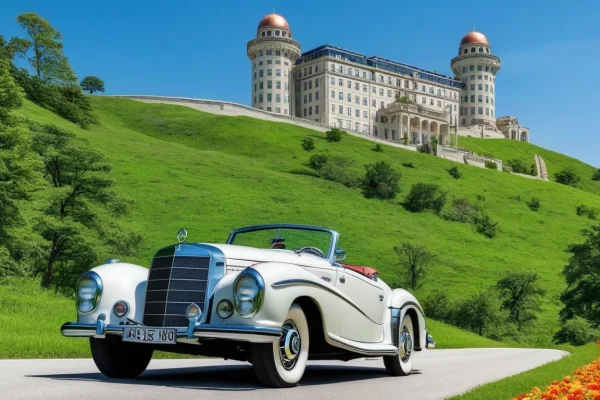Who Inspired the Success of Mercedes-Benz?

The story of Mercedes-Benz is not just about luxury cars; it’s a tale of innovation, vision, and relentless pursuit of excellence. The brand’s success has been shaped by a multitude of influential figures and groundbreaking concepts that have left an indelible mark on the automotive industry. Who are these key players that inspired the rise of such an iconic name? Let’s dive into the fascinating world of Mercedes-Benz and uncover the inspirations that fueled its journey to the top.
At the heart of Mercedes-Benz’s legacy are its founders, Gottlieb Daimler and Karl Benz. These pioneers were driven by a passion for engineering and a vision to create vehicles that would revolutionize transportation. Their innovative spirit laid the groundwork for the brand’s commitment to quality and performance, setting a high standard for the luxury automobile market. The partnership of these two visionaries not only birthed the first gasoline-powered car but also established a brand that would become synonymous with prestige and reliability.
Another significant influence has been the brand’s dedication to technological innovations. Mercedes-Benz has always been at the forefront of automotive advancements. For instance, the introduction of safety features such as anti-lock braking systems and airbags has not only enhanced vehicle safety but has also set new industry standards. These innovations reflect the brand’s commitment to ensuring that both drivers and passengers are protected on the road.
| Innovation | Year Introduced | Impact |
|---|---|---|
| Anti-lock Braking System | 1978 | Improved vehicle control during braking |
| Airbags | 1981 | Enhanced passenger safety |
| Electronic Stability Control | 1995 | Reduced risk of skidding |
Moreover, the racing heritage of Mercedes-Benz has played a crucial role in its success. The brand’s participation in motorsports has been a testing ground for innovations, showcasing its engineering prowess to a global audience. This competitive spirit not only enhances the brand’s reputation but also drives continuous improvement in performance and technology.
In conclusion, the success of Mercedes-Benz is a tapestry woven from the threads of visionary founders, technological advancements, and a rich racing heritage. These elements combined have inspired a brand that stands as a beacon of luxury and innovation in the automotive world. As we look forward, it’s clear that the legacy of those who inspired Mercedes-Benz will continue to shape its future.
Founders and Visionaries
The story of Mercedes-Benz is not just about cars; it’s about the remarkable individuals whose dreams and innovations paved the way for one of the most prestigious automotive brands in the world. Imagine a time when the automobile was merely a concept, and then picture the visionaries who turned that concept into reality. The founders—Carl Benz and Gottlieb Daimler—were not just engineers; they were pioneers who dared to dream big.
Carl Benz, known for creating the first true automobile powered by an internal combustion engine, laid the foundation for what would become Mercedes-Benz. His relentless pursuit of innovation led to the invention of the Motorwagen in 1886, a vehicle that would change the course of history. On the other hand, Gottlieb Daimler, with his passion for speed and performance, contributed significantly to the development of high-speed engines and the concept of the modern automobile. Together, their contributions have established a legacy that continues to inspire.
| Founder | Key Contribution | Year |
|---|---|---|
| Carl Benz | Invented the first automobile | 1886 |
| Gottlieb Daimler | Developed high-speed engines | 1889 |
These visionaries didn’t just create vehicles; they set a new standard for luxury and performance in the automotive industry. Their commitment to engineering excellence and innovative design has been the cornerstone of the Mercedes-Benz brand. As we explore further, it’s essential to acknowledge how their pioneering spirit continues to resonate within the company today.
Moreover, the ethos of Mercedes-Benz is deeply rooted in their vision. They believed in creating not just cars, but experiences that resonate with consumers. This belief is reflected in the brand’s tagline: “The Best or Nothing.” Such a powerful statement encapsulates the commitment to quality and excellence that these founders instilled in the company. So, the next time you see a Mercedes-Benz on the road, remember the incredible journey of its founders and the vision that brought this iconic brand to life.
Technological Innovations
The journey of Mercedes-Benz has been marked by a relentless pursuit of that have not only defined the brand but also transformed the entire automotive landscape. From the moment the first engine roared to life, the engineers and visionaries at Mercedes-Benz have been driven by a singular goal: to push the boundaries of what is possible in vehicle design and performance. This commitment to innovation is evident in every model they produce, making the brand synonymous with cutting-edge technology.
One of the most significant contributions from Mercedes-Benz to the automotive world has been in the realm of safety. The introduction of groundbreaking technologies has set new benchmarks, ensuring that safety is never compromised. For instance, the development of the anti-lock braking system (ABS) has revolutionized how vehicles handle in critical situations, allowing drivers to maintain control during sudden stops. In addition to ABS, the incorporation of airbags has become a standard feature in vehicles worldwide, saving countless lives.
| Innovation | Year Introduced | Impact |
|---|---|---|
| Anti-lock Braking System (ABS) | 1978 | Improved vehicle control during braking |
| Airbags | 1980 | Enhanced passenger safety in collisions |
| Electronic Stability Program (ESP) | 1995 | Reduced risk of skidding and loss of control |
Moreover, Mercedes-Benz has consistently embraced the evolution of technology by integrating advanced features into their vehicles. The brand has pioneered innovations such as:
- Adaptive Cruise Control: Automatically adjusts the vehicle’s speed to maintain a safe distance from the car ahead.
- Lane Keeping Assist: Helps prevent unintended lane departures, enhancing driver safety.
- Infotainment Systems: Offering seamless connectivity with smartphones and providing an intuitive user experience.
In essence, the technological innovations introduced by Mercedes-Benz have not only enhanced the driving experience but have also set industry standards that others aspire to meet. As we look to the future, one can only imagine what groundbreaking advancements this iconic brand will unveil next. Who knows? The next leap in automotive technology might just be around the corner, waiting to be pioneered by Mercedes-Benz.
Early Engine Development
The journey of Mercedes-Benz in the automotive world is nothing short of remarkable, especially when we delve into the realm of early engine development. This phase was crucial, not only for the brand but also for the entire automotive industry. The engineers at Mercedes-Benz were visionaries, pushing the boundaries of what was possible with engine technology. Their relentless pursuit of excellence led to innovations that would define the future of motoring.
In the late 19th and early 20th centuries, the automotive landscape was still in its infancy. The founders of Mercedes-Benz, Karl Benz and Gottlieb Daimler, were pioneers who recognized the potential of the internal combustion engine. They worked tirelessly to refine engine designs, focusing on performance and efficiency. Their groundbreaking work laid the foundation for what would become a legacy of engineering prowess.
One of the key milestones in early engine development was the introduction of the four-stroke engine. This innovation allowed for greater power output and efficiency, setting a new standard in the industry. The table below highlights some of the significant advancements made during this period:
| Year | Innovation | Impact |
|---|---|---|
| 1885 | First gasoline-powered car | Foundation of modern automotive engineering |
| 1901 | Mercedes 35 HP | Introduced the concept of a sports car |
| 1926 | First diesel engine in passenger cars | Enhanced fuel efficiency and performance |
These innovations were not just technical achievements; they represented a shift in how people viewed automobiles. The early engines developed by Mercedes-Benz were not only about getting from point A to B but also about the experience of driving. This passion for performance and quality has remained a core value of the brand.
In conclusion, the early engine development at Mercedes-Benz was a pivotal moment in automotive history. It showcased the brand’s commitment to innovation and excellence, inspiring future generations of engineers and car enthusiasts alike. As we look back, it’s clear that the seeds planted by these early pioneers continue to flourish, making Mercedes-Benz a leader in the automotive industry today.
Racing Heritage
The of Mercedes-Benz is not just a chapter in the brand’s history; it is a vibrant tapestry woven with triumphs, innovations, and a relentless pursuit of excellence. From the early days of motorsport, Mercedes-Benz has embraced racing as a proving ground for its engineering prowess. This commitment has not only elevated the brand’s status but has also influenced the entire automotive industry.
One of the most significant milestones in this journey was the introduction of the Mercedes-Benz W125, which dominated the racing scene in the late 1930s. With its powerful engine and aerodynamic design, the W125 set records that stood for decades. This car was a testament to the brand’s dedication to performance and innovation, showcasing how racing can inspire technological advancements.
Moreover, Mercedes-Benz’s participation in prestigious events like the Le Mans 24 Hours and Formula 1 has allowed the brand to test its limits and push boundaries. These competitions are not merely races; they are a platform where innovation meets adrenaline. The lessons learned on the racetrack have translated into cutting-edge technologies that enhance the safety and performance of their road cars.
| Year | Event | Notable Achievement |
|---|---|---|
| 1934 | German Grand Prix | First place with the W25 |
| 1952 | Formula 1 | Constructors’ Championship Winner |
| 1971 | Le Mans 24 Hours | First place with the 300 SL |
In addition to technical advancements, the of Mercedes-Benz has created a passionate community of fans and enthusiasts. The brand’s success on the racetrack has fostered a sense of pride and loyalty among its customers. As they say, “Winning breeds winning,” and this sentiment resonates deeply with the Mercedes-Benz identity.
In conclusion, the racing heritage of Mercedes-Benz is a powerful influence that has shaped the brand’s identity and technological advancements. By embracing the spirit of competition, Mercedes-Benz continues to inspire future generations of automotive enthusiasts and engineers alike.
Influential Designers
The legacy of Mercedes-Benz is not solely built on engineering marvels and technological advancements; it is also profoundly shaped by the vision of its influential designers. These creative minds have not only crafted stunning vehicles but have also established a unique aesthetic that resonates with luxury and sophistication. Imagine the sleek lines of a Mercedes, each curve meticulously designed to evoke emotion and admiration. This isn’t just about looks; it’s about creating a driving experience that feels like art in motion.
Throughout the years, several key designers have left an indelible mark on the Mercedes-Benz brand, each contributing their unique flair and vision. For instance, the legendary Gottlieb Daimler and Karl Benz were not just founders but also visionaries who understood the importance of design in automotive success. Their early models set the stage for what would become a hallmark of the brand: a perfect blend of form and function.
In more recent times, designers like Peter Pfeiffer and Gordon Wagener have taken the helm, pushing the boundaries of automotive design. Pfeiffer’s work on the SLK and CLS models exemplifies how Mercedes-Benz embraces both tradition and modernity. Meanwhile, Wagener has been pivotal in the development of the “Sensual Purity” design philosophy, which emphasizes clean lines and a harmonious balance between elegance and sportiness.
| Designer | Notable Contributions |
|---|---|
| Gottlieb Daimler | Co-founder and early innovator in automotive design |
| Karl Benz | Creator of the first true automobile |
| Peter Pfeiffer | Designed iconic models like the SLK and CLS |
| Gordon Wagener | Introduced the “Sensual Purity” design philosophy |
These designers, among others, have not only shaped the vehicles but have also influenced the brand’s identity, ensuring that each model is a testament to the innovative spirit of Mercedes-Benz. Their work has redefined luxury in the automotive world, making each car not just a means of transportation but a statement of style and prestige. So, the next time you see a Mercedes-Benz gliding down the road, remember that it’s not just a car; it’s a masterpiece crafted by some of the most influential designers in the industry.
Safety Innovations
The journey of Mercedes-Benz in the realm of automotive safety is nothing short of revolutionary. With a commitment to prioritizing driver and passenger safety, the brand has consistently introduced groundbreaking technologies that have not only enhanced the safety of their vehicles but have also set new industry standards. Think about it: when you step into a Mercedes-Benz, you’re not just entering a car; you’re stepping into a fortress designed with your safety in mind.
One of the most significant milestones in this journey was the introduction of the anti-lock braking system (ABS). This technology, which prevents the wheels from locking during hard braking, has saved countless lives and has become a standard feature in modern vehicles across the globe. Another game-changer was the development of airbags, which cushions the impact during a collision, reducing the risk of injury. These innovations are just the tip of the iceberg when it comes to the safety features that Mercedes-Benz has pioneered.
To give you a clearer picture of the impact of these innovations, let’s take a look at a table summarizing some of the key safety technologies developed by Mercedes-Benz:
| Innovation | Year Introduced | Impact |
|---|---|---|
| Anti-lock Braking System (ABS) | 1978 | Enhanced vehicle control during braking |
| Airbags | 1980 | Reduced risk of injury in collisions |
| Electronic Stability Program (ESP) | 1995 | Improved vehicle stability and control |
| Pre-Safe System | 2002 | Prepares the vehicle for an impending collision |
Mercedes-Benz doesn’t just stop at individual innovations; they also focus on integrating these technologies to create a comprehensive safety network within their vehicles. For instance, the Pre-Safe system not only detects potential collisions but also activates safety measures like tightening seat belts and adjusting seats to protect occupants better. It’s like having a guardian angel watching over you while you drive!
In conclusion, the legacy of Mercedes-Benz in safety innovations is a testament to their unwavering dedication to protecting lives. As the automotive industry continues to evolve, one thing remains clear: Mercedes-Benz will always be at the forefront, inspiring others to prioritize safety in their designs.
Marketing Strategies
The success of Mercedes-Benz can be attributed not only to its engineering excellence but also to its effective marketing strategies. In a world where luxury brands vie for consumer attention, Mercedes-Benz has carved out a unique space that resonates with its audience. But how did they do it? By mastering the art of storytelling and creating an emotional connection with their customers. This brand doesn’t just sell cars; it sells a lifestyle, an aspiration, and a promise of quality and prestige.
One of the key tactics employed by Mercedes-Benz is its strategic brand positioning. The brand has consistently focused on three core pillars: quality, luxury, and innovation. This positioning allows Mercedes-Benz to stand out in a crowded market, appealing to discerning consumers who seek more than just a mode of transportation. The company’s marketing campaigns often showcase the performance and elegance of their vehicles, reinforcing the idea that owning a Mercedes-Benz is a symbol of success.
To further enhance its market presence, Mercedes-Benz has implemented a variety of global expansion strategies. By establishing a foothold in emerging markets, the brand has adapted to diverse consumer preferences while maintaining its core values. This adaptability is crucial in a globalized economy where tastes and trends can vary dramatically. The following table illustrates some of the key markets and their respective strategies:
| Market | Strategy |
|---|---|
| China | Local manufacturing and tailored marketing campaigns |
| India | Affordable luxury models to attract younger consumers |
| Europe | Emphasis on sustainability and eco-friendly technologies |
Moreover, Mercedes-Benz leverages digital marketing strategies to connect with a younger audience. Social media platforms such as Instagram and Facebook have become essential tools for showcasing their latest models and engaging with fans. By sharing visually stunning content and behind-the-scenes glimpses of their vehicles, they create a buzz that keeps their audience coming back for more. As a result, Mercedes-Benz not only maintains its prestigious image but also attracts a new generation of customers eager to embody the brand’s legacy.
In conclusion, the marketing strategies of Mercedes-Benz are a testament to the brand’s understanding of its audience and the luxury automotive market. By focusing on quality, innovation, and emotional engagement, they have successfully inspired loyalty and admiration, ensuring their place at the forefront of the automotive industry.
Brand Positioning
Mercedes-Benz has masterfully crafted its brand positioning to resonate with luxury consumers worldwide. This positioning is not just about selling cars; it’s about creating an experience that embodies sophistication, quality, and innovation. Imagine walking into a room filled with luxury vehicles, each one whispering tales of engineering excellence and timeless design. That’s the essence of Mercedes-Benz.
At the heart of this positioning strategy are several key elements that define the brand’s identity:
- Quality: Every vehicle is a testament to meticulous craftsmanship and attention to detail.
- Luxury: The brand is synonymous with opulence, offering features that pamper the senses.
- Innovation: Mercedes-Benz consistently pushes the boundaries of technology, ensuring that each model is equipped with cutting-edge advancements.
To further illustrate the brand’s positioning, let’s take a look at a table that highlights some of the core values that set Mercedes-Benz apart from its competitors:
| Core Value | Description |
|---|---|
| Heritage | Over a century of automotive excellence, establishing a legacy of trust. |
| Performance | Unmatched engineering that delivers superior driving experiences. |
| Safety | Innovative safety features that prioritize driver and passenger protection. |
Mercedes-Benz’s brand positioning is not static; it evolves with the market trends and consumer preferences. The company has embraced digital marketing strategies, utilizing social media platforms to engage with a younger audience while maintaining its classic image. This dual approach ensures that the brand remains relevant in an ever-changing landscape.
In conclusion, the success of Mercedes-Benz can be largely attributed to its strategic brand positioning. By focusing on quality, luxury, and innovation, Mercedes-Benz not only appeals to its target demographic but also creates a lasting emotional connection with its consumers. As the brand continues to evolve, it remains a beacon of excellence in the automotive industry, inspiring both admiration and aspiration.
Global Expansion
The journey of Mercedes-Benz into global markets is nothing short of remarkable. As the brand sought to establish a foothold in various regions, it adapted its strategies to meet the unique demands of diverse consumer bases. This adaptability has not only fueled the brand’s growth but also solidified its status as a leader in the luxury automotive industry. Have you ever wondered how a brand can become synonymous with luxury across different cultures? It’s all about understanding local preferences while maintaining core values.
One of the key factors in Mercedes-Benz’s successful global expansion has been its ability to resonate with local markets. By investing in research and development tailored to specific regions, the brand has managed to create vehicles that cater to the tastes and expectations of consumers worldwide. For instance, in Asia, where compact vehicles are often preferred, Mercedes-Benz introduced models that combine luxury with functionality. On the other hand, in markets like North America, larger SUVs and sedans have been emphasized.
| Region | Preferred Vehicle Type | Key Strategy |
|---|---|---|
| Asia | Compact Luxury Cars | Focus on efficiency and style |
| North America | Luxury SUVs | Highlight spaciousness and technology |
| Europe | Performance Sedans | Emphasize engineering excellence |
Moreover, Mercedes-Benz has embraced the digital age, utilizing online platforms to reach potential customers. Social media campaigns and targeted advertisements have played a vital role in building brand awareness and engaging with audiences. This modern approach to marketing has allowed the brand to connect with younger consumers who are increasingly influential in the automotive market.
In conclusion, the global expansion of Mercedes-Benz is a testament to its innovative spirit and commitment to understanding diverse consumer needs. By blending local insights with its rich heritage of luxury and performance, the brand continues to thrive on the world stage. As the automotive landscape evolves, who knows what exciting developments lie ahead for this iconic brand?
Frequently Asked Questions
- Who were the founders of Mercedes-Benz?
The founders of Mercedes-Benz, Karl Benz and Gottlieb Daimler, were visionary engineers whose innovative ideas and commitment to quality laid the foundation for the brand’s success in the automotive world.
- What are some key technological innovations by Mercedes-Benz?
Mercedes-Benz has pioneered numerous technological advancements, including anti-lock braking systems, airbags, and cutting-edge engine designs that have significantly influenced automotive safety and performance.
- How has racing influenced Mercedes-Benz?
Racing has been a crucial part of Mercedes-Benz’s heritage, allowing the brand to test and showcase its engineering capabilities, which not only enhances performance but also elevates its reputation globally.
- What role do designers play in the brand’s success?
Influential designers at Mercedes-Benz have been instrumental in creating iconic vehicles, blending aesthetics with functionality, and establishing the brand’s luxurious image that appeals to consumers worldwide.
- How does Mercedes-Benz ensure safety in its vehicles?
Mercedes-Benz prioritizes safety by developing innovative technologies that set industry standards, such as advanced braking systems and comprehensive airbag systems, ensuring the well-being of drivers and passengers.
- What marketing strategies has Mercedes-Benz employed?
The brand has utilized effective marketing strategies to create a strong identity focused on luxury and innovation, helping it maintain a prestigious image in a competitive automotive market.
- How has Mercedes-Benz expanded globally?
Through strategic global expansion, Mercedes-Benz has established a presence in emerging markets, adapting to diverse consumer preferences while staying true to its core values of quality and luxury.





